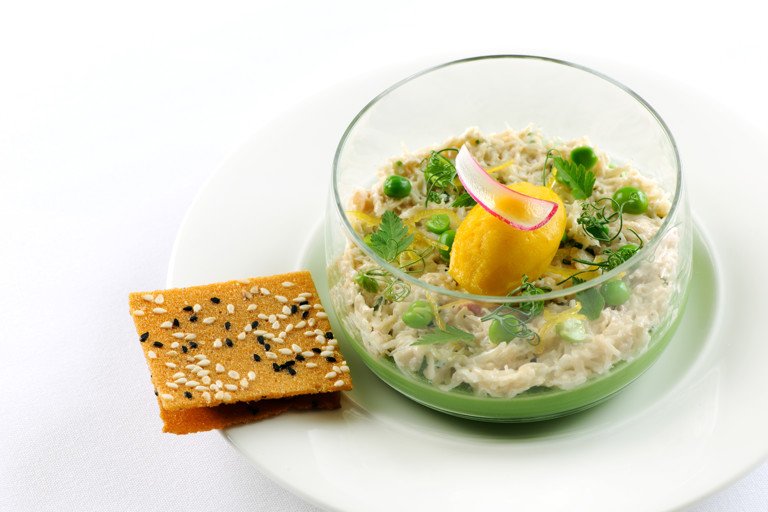Sweet pea panna cotta with crab and cicely, mango and dashi sorbet, brown crab toast
Item 1 of 1
- 8
- 3 hours
This audacious sweet pea panna cotta recipe from Simon Hulstone toes the line between starter and dessert, containing a few elements usually found in a sweet context - like mango sorbet and panna cotta. Don't let this put you off, though, the combination of savoury and sweet dazzles the tastebuds.
First published in 2015
discover more:
Ingredients
Metric
Imperial
Sweet pea panna cotta
- 300ml of chicken stock
- 335g of peas
- 150g of unsalted butter
- 50ml of double cream
- 20g of caster sugar
- 8g of salt
- 3/4 bronze gelatine leaf
Crab mayonnaise
- 1 crab, live
- 3 egg yolks
- 1 tsp Dijon mustard
- 1 tbsp of white wine vinegar
- 1 handful of breadcrumbs
- salt to taste
- 200ml of vegetable oil
Brown crab toast
- 122g of unsalted butter
- 100g of egg white
- 100g of plain flour
- 480ml of maple syrup
- 35ml of reduced crab stock
- sesame seeds
- black onion seeds
Mango and dashi sorbet
- 200g of mango purée
- 200ml of water
- 40ml of glucose syrup
- 1/2 tbsp of dashi
Confit lemon
- 2 lemons
- 30g of sugar
- 30ml of white wine vinegar
To serve
- 20g of shelled peas
- sweet cicely
- pea shoots
SAVE RECIPE
Equipment
- Ice cream maker
Method
1
For the mango and dashi sorbet, dissolve the glucose and dashi with the mango purée and water, churn in an ice cream maker and freeze until required
- 200g of mango purée
- 200ml of water
- 40ml of glucose syrup
- 1/2 tbsp of dashi
2
For the tuiles, start by making a beurre noisette. Heat the butter until it turns a nut-brown colour – immediately pass through a sieve into a cold pan to stop the cooking process and avoid burning
- 122g of unsalted butter
3
Weigh out 100ml of the beurre noisette and blend together with the egg white. Mix in the flour until smooth, then add the maple syrup
- 100g of egg white
- 100g of plain flour
- 480ml of maple syrup
4
Add the crab stock and leave to rest for 6 hours. Once rested, spread the mixture evenly and thinly onto a non-stick slip mat and evenly sprinkle over sesame and black onion seeds
- 35ml of reduced crab stock
- sesame seeds
- black onion seeds
5
Preheat the oven to 145°C/gas mark 1.5
6
Cook the tuilles in the oven until they are slightly set. Remove from the oven and cut into 4cm squares, then place back into the oven for a further 4 minutes at 155°C. Using a palette knife, carefully remove the tuilles from the sheet and set aside until ready to serve
7
For the sweet pea panna cotta, bring all ingredients apart from the gelatine up to a gentle simmer for 5 minutes. Blitz and pass the liquid through a strainer and check seasoning
- 300ml of chicken stock
- 335g of peas
- 150g of unsalted butter
- 50ml of double cream
- 20g of caster sugar
- 8g of salt
8
Soak 3/4 of a bronze leaf of gelatine in cold water until soft. Weigh out 400g of the sweet pea cream and whisk in the gelatine whilst still warm. Pour a small amount into the bottom of each serving glass and store in the fridge until set
- 3/4 bronze gelatine leaf
9
Render the crab insensate by placing it in the freezer for and hour or so. Steam or boil the crab for 12-15 minutes depending on size and refresh in ice cold water
- 1 crab, live
10
Meanwhile, make the mayonnaise by whisking the egg yolks, mustard and vinegar together in a large bowl. Whilst continuously whisking, pour in the oil in a slow, steady stream so that it emulsifies and thickens to the consistency of mayonnaise. Season and store in the fridge until required
- 1 tbsp of white wine vinegar
- 3 egg yolks
- 1 tsp Dijon mustard
- salt to taste
- 200ml of vegetable oil
11
Crack the crab claws and pick out all the white crab meat. Pick through the meat a few times to remove all the shell. Mix with a small amount of the mayonnaise until the right consistency and check for seasoning
- 1 handful of breadcrumbs
12
Remove all of the brown meat from the crab's body and mix with breadcrumbs. Season and mix until it has a more pliable consistency
13
Peel the lemons, keeping the strips as whole as possible. Blanch them 3 times in separate pans of boiling water
- 2 lemons
14
Meanwhile, to make a stock syrup, combine the white wine vinegar and sugar in a pan and reduce until you are left with a syrupy consistency. Remove from the heat and chill
- 30ml of white wine vinegar
- 30g of sugar
15
Slice the blanched lemon very thinly and add the slices to the chilled syrup
16
To serve, place a spoonful of crab mayonnaise onto each pea panna cotta and flatten down. Top with the popped garden peas, the confit lemon strips, followed by the sweet cicely and or pea shoots
- 20g of shelled peas
- pea shoots
- sweet cicely
17
Make sandwiches using the tuiles and the brown crab meat and serve next to the panna cotta on each plate. Arrange a quenelle of the mango and dashi sorbet on the top of each panna cotta and serve
Get in touch
Please sign in or register to send a comment to Great British Chefs.


